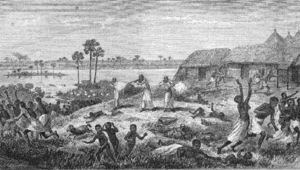3,500 regular soldiers
Around 10,000 total. ~10,000 men Result Free State victory | Period 1892 – 1894 Location Congo Free State | |
 | ||
Similar First Franco‑Dahomean War, Battle of Geok Tepe, Siamese–Vietnamese War, Arikara War, Victorio's War | ||
The Congo Arab war (also known as the Congolese-Arab war and the Belgo-Arab War) took place in what is now the Democratic Republic of the Congo between the forces of Belgian King Leopold II's Congo Free State and various Zanzibari "Arab" slave traders led by Sefu bin Hamid, the son of Tippu Tip. Fighting occurred in the eastern Congo between 1892 and 1894. It was a proxy war, with most of the fighting being done by native Congolese, who aligned themselves with either side and sometimes switched sides. The causes of the war were mainly economic, since Leopold and the Arabs were contending to gain control of the wealth of the Congo. The war ended in January 1894 with a victory of Leopold's forces. Initially King Leopold collaborated with the Arabs but competition over the control of ivory turned his stance to confrontational. The war against the Swahili-Arab economic and political power was presented as a Christian anti-slavery crusade.
Contents
Prelude
In 1886, while Tippu Tip was in Zanzibar, a dispute arose between a Congo Free State fort at Stanley Falls, led by Tip, and a smaller, nearby fort led by Walter Deane andDubois. Tip's men at the Stanley Falls fort alleged that Deane had stolen a slave woman from an Arab officer there. Deane asserted that the girl had fled after being badly beaten by her master, and that he had only offered her refuge. Tip's men attacked the fort and after a four-day siege, the defenders ran out of ammunition and fled, abandoning the fort. The Free State made no counterattack, and Tip began to move more men into the Congo, including several Arab slave captains and also some Congolese leaders, such as Gongo Lutete.
In March and April 1892, Tip's son Sefu began to lead attacks on various Congo Free State (CFS) personnel in the eastern Congo, including the British ivory trader Arthur Hodister and Captain Guillaume Van Kerckhoven, who had been taking ivory by force from Arab traders. Relations were further strained when Rahsid, Tippu Tib's nephew and resident Arab leader in Stanley Falls, refused to assist in the investigation of Hodister's death. Gongo Luteta also led actions in the east at this time, but defected to the Force Publique after suffering a defeat early on.
By October 1892, Sefu was leading a force of 10,000 men, some 500 Zanzibari officers and the rest Congolese. The Belgian Force Publique, led by Francis Dhanis, consisted of a few dozen Belgian officers commanding several thousand African auxiliaries.
Course of the war
Open warfare broke out in late November 1892, when Sefu set up a fort on the Lomami River, where he was attacked by the Force Publique and defeated. Dhanis used this battle as a pretext for advancing against the Arabs in force.
He allowed his army to travel with all of their wives, slaves, and servants, who did all of the army's cooking and cleaning and acted as a supply train. In addition, he did not allow his men to harm local non-combatants, earning him goodwill of the local Congolese people.
In early 1893 the Free State took the key river city of Nyangwe after a 6-week siege that devastated the city. Of 1000 original buildings in the city, only one remained standing after the siege. Later, Free State forces took Kasongo, in the north. The war's last major battle occurred on 20 October 1893, on the Luama River, west of Lake Tanganyika. It was a tactical stalemate, but Sefu was killed, and the remaining resistance soon fell apart. The war ended in Free State victory by January 1894.
Aftermath and impact
The political and economic geography of the Congo was significantly altered by the war. The market around Nyangwe ceased to exist, while the city of Kasongo was all but destroyed. With the absence of these markets and the Arab traders themselves, much of the exports of the Congo were rerouted from their destinations in East Africa to Stanley Pool and the Atlantic ocean.
